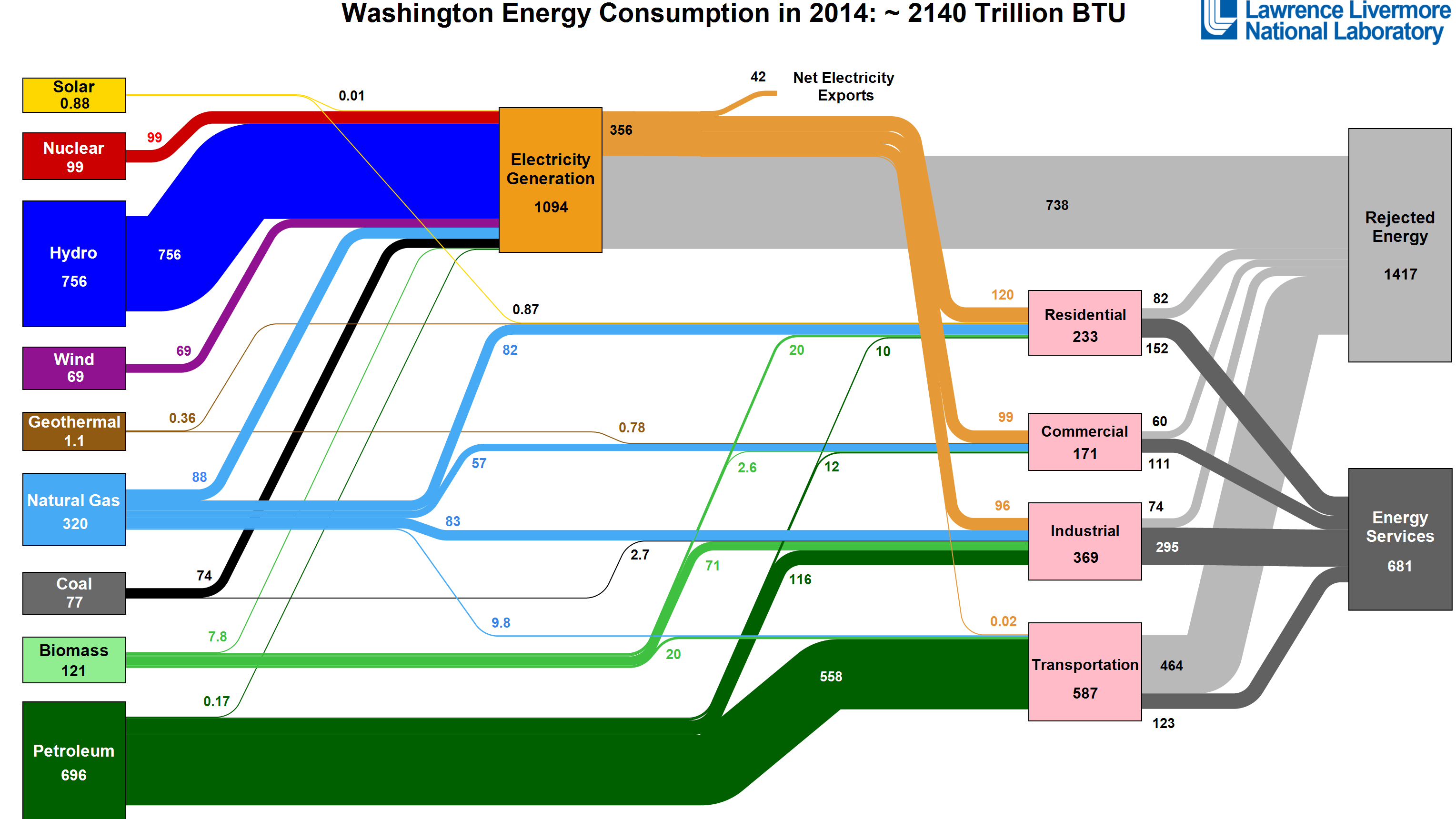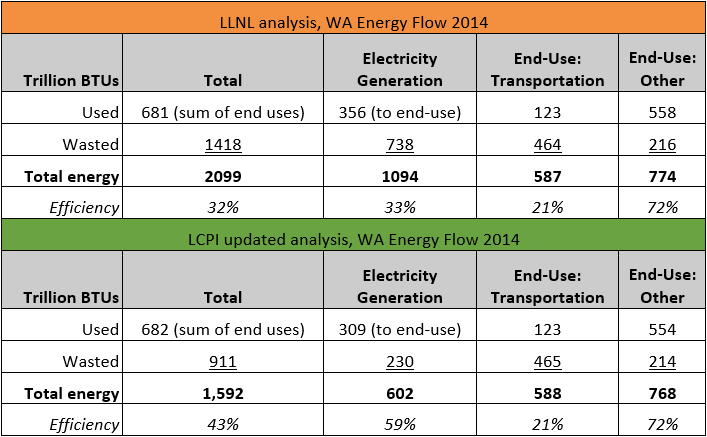Section 1: Updating the Sankey Diagram
Figure 1: LLNL Sankey Diagram for Washington Energy Consumption, 2014

LLNL August, 2016. Data is based on DOE/EIA SEDS (2014).
Sankey Diagrams, like those produced by LLNL, are an information-rich visual depiction of energy or other (e.g. carbon, money) flows from inputs to final use. In developing Sankey Diagrams for state energy consumption that track primary energy inputs to end-use consumption, LLNL carries some important assumptions through from the Energy Information Agency’s (EIA) State Energy Data System (SEDS). 1 The SEDS data report fuel inputs for all sectors (Commercial, Industry, Residential, Transportation, and Electricity Generation) for fossil fuels and if electricity is consumed for end-use. For non fossil-fuel electricity generation, the SEDS data is instead reported in electricity outputs.
Critical for WA is the assumption that non-thermal power plants (e.g. wind, hydropower) operate at the same conversion efficiency of roughly 33% (Power Plant Output / Energy Input to Power Plant) as the average fossil fuel power plant. Rather than a blanket 33% conversion efficiency for different power generating resources, a more relevant estimate of the conversion efficiency for non-thermal resources is notional efficiency, which is estimated at 90% for hydropower. 2 While the adjustment for hydropower efficiency is by far the largest needed correction to the LLNL methodology, notional efficiency for wind (26%) 3 and state-specific thermal plant conversion efficiencies for natural gas, wind, and nuclear also improve accuracy of state-level Sankey Diagrams, and were also applied to this analysis. 4
Whereas hydropower represents only around 7% of net electricity generation in the USA, it represents around two-thirds of electricity generation and consumption in Washington. 5 At the national level, making such an adjustment would only shift energy waste and total energy consumption estimates a few percentage points. However, for Washington state, the impact is much more substantial, as shown by the data comparison compiled in Table 1. Our assessment finds over two-thirds less wasted energy in the power sector in 2014 than the original LLNL analysis. Extending to 2015, the most recent year of data availability, indicates a 56% power sector conversion efficiency for Washington State which is significantly higher than the blanket 33% thermal efficiency originally applied by to all power plants by LLNL (Figure 1). 6
Table 1: LLNL and updated energy flows for Washington, 2014
7

Another important adjustment within the power sector is shifting from the “production-basis” of the SEDS data and LLNL analysis, which assigns all power produced in Washington to Washington regardless of imports or exports, to a “consumption-basis” that counts all power consumed in Washington taking into consideration imported and exported electricity based on Fuel Mix Disclosure Reports. 8 The “consumption-basis” is more analogous to both the LLNL treatment of end-use consumption in other sectors and the methodology for the Washington State Greenhouse gas inventory. To illustrate the difference, we highlight one example from 2014 data. In the LLNL approach, more power output comes from natural gas (9.6% of total output) than wind (6.3%) or coal (5.9%). However, on a consumption-basis coal power output share nearly triples (15.5%) while natural gas share rises only slightly (10.5%), and wind power share drops over half (2.5%).
Section 2: Carbon content of wasted energy
CaPI analysis estimates around 50 million metric tons of carbon dioxide (MtCO2) associated with wasted energy in 2015. The last Greenhouse Gas Inventory for Washington state determined just over 94 MtCO2 equivalents were emitted in 2013. Here we provide a brief description of the calculation of 50 MtCO2.
Carbon Content of Fuel
For each of the primary fossil fuels (coal, petroleum, and natural gas), the carbon dioxide emission as a function of heat content are known. These are known as the carbon dioxide emission coefficients, which are highest for coal (95.35 metric tons CO2 per billion BTU), then petroleum (71.30 tons per billion BTU, using gasoline as a proxy), and natural gas (53.07 tons per billion BTU). With these emissions coefficients, the total carbon emissions are determined by multiplying by the consumption of fuels in BTUs. For the wasted energy share, the carbon emissions are multiplied by the conversion efficiency from fuel into useful energy.
For example, coal consumption for power production in 2015 was 158 trillion BTU 9. At 95.35 tons per billion BTU, burning that much coal creates 15.1 MtCO2. At a conversion efficiency of 31%, only 4.7 MtCO2 translate to power produced with the remaining 10.4 MtCO2 associated with the unusable heat from coal power production.
We repeat this exercise for each fossil fuel and in the power generation, transport, residential, commercial, and industrial sectors. Those results are summarized in Table 4.
Table 4: Carbon dioxide emissions from unused energy, Washington state, 2015
|
FUEL / SECTOR |
MtCO2 from unused energy |
|
Power Generation, Coal |
10.4 |
|
Power Generation, Other |
2.9 |
|
End-Use, Transport |
33.7 |
|
End-Use, Other |
7.6 |
|
TOTAL, UNUSED ENERGY |
54.7 |
|
94.4 |
|
|
Share of Statewide Emissions |
58% |
